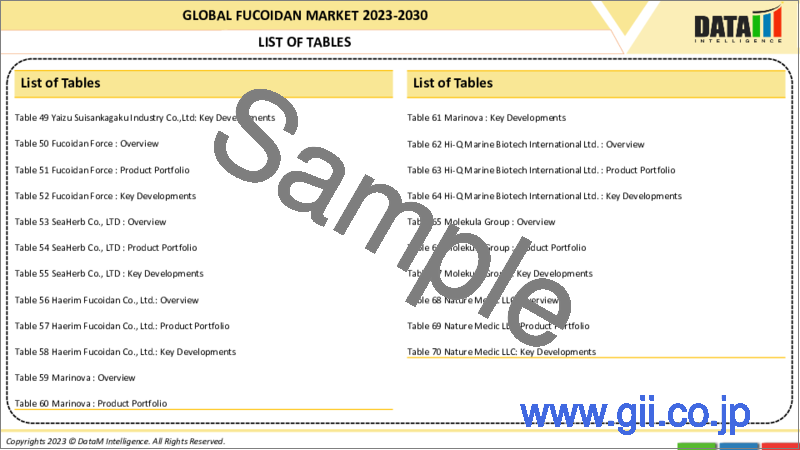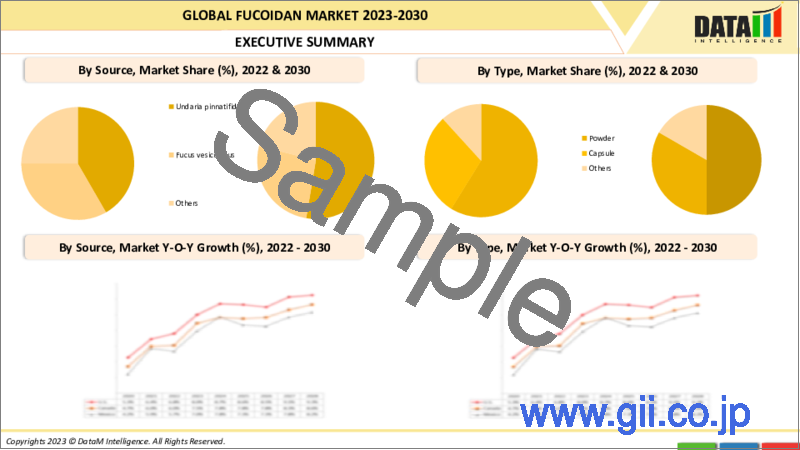|
|
市場調査レポート
商品コード
1359941
フコイダンの世界市場-2023年~2030年Global Fucoidan Market - 2023-2030 |
||||||
カスタマイズ可能
適宜更新あり
|
|||||||
| フコイダンの世界市場-2023年~2030年 |
|
出版日: 2023年10月11日
発行: DataM Intelligence
ページ情報: 英文 186 Pages
納期: 即日から翌営業日
|
- 全表示
- 概要
- 目次
概要
世界のフコイダン市場は、2022年に9,050万米ドルに達し、2023年から2030年の予測期間にCAGR 10.6%で成長し、2030年には2億260万米ドルに達すると予測されています。
天然健康製品や天然素材に対する需要の高まりにより、フコイダン市場は最近拡大しています。フコイダンは、一般的にカプセルや粉末のサプリメントとして、様々な飲食品や飲料に利用されています。フコイダンの市場は、オーガニック製品に対する需要の高まり、健康意識の高まり、慢性疾患の増加などの要因によって影響を受けています。フコイダンは、免疫疾患、がん、心血管疾患の治療において多くの潜在的な利点があります。
フコイダンの世界の需要は、医薬品分野の成長とともに増加しています。フコイダンには抗酸化作用があります。また、抗腫瘍剤、抗血管新生剤、抗ウイルス剤、抗炎症剤、抗凝固剤、抗血栓剤としても使用されています。スキンケアや化粧品業界でも、フコイダンの利用が進んでいます。フコイダンは、肌の弾力性や保水性を維持するために、多くの利点を持っています。
アンチエイジング・スキンケア製品など、新しい化粧品処方の開発において、フコイダンは現在研究されている天然代替成分です。例えば、英国のOCEANIUM社は、2023年5月に高純度の生理活性成分「OCEAN ACTIVES Fucoidan」を開発し、化粧品会社はこれを使用して様々なスキンケア製品を開発することができます。これと同様に、ルミナクト・ブライトとルミナクト・リバースは、フコイダン原料のサプライヤーであるマリノバ社が、ドイツに本社を置く特殊化学品メーカーであるイノスペック社と共同で開発した化粧品原料です。
ダイナミクス:
微細藻類の抽出と培養を改善する努力の拡大
栄養食品やサプリメントの市場では、藻類由来のフコイダンの需要が増加しています。酵母由来のβグルカンなど他のβグルカンに比べ、藻類βグルカンは安価です。さらに、数種の褐藻類は、主に細胞壁マトリックス上にフコイダンを含んでいます。微細藻類からのβ-グルカンおよびフコイダン抽出物は、現在広範な研究の対象となっています。その結果、市場は拡大しています。生産能力を向上させることで、微細藻類原料のサプライヤーは、フコイダン市場における顧客の要求を満たすために継続的に取り組んでいます。
例えば、米国のバイオテクノロジー企業であるF3 Platform Biologics社は、2019年8月に微細藻類ユーグレナグラシリスからβ-1グルカンとβ-3グルカンを生産するライセンスと権利をAlgatech Ltd.に付与しました。さらに、微細藻類培養のための抽出方法を開発することで、生産者は食品、栄養補助食品、ヘルスケアを含むさまざまな産業でβグルカン微細藻類をうまく利用できるようになります。数多くの組織が、この点で多くの努力を行っています。これらの要因は、市場全体の拡大をすぐにサポートすると予想されます。
世界各国での心血管疾患とがんの症例増加
先進諸国では、心臓病と脳卒中が成人の死亡者数の1位と2位を占めています。治療が急務となる前に予防に役立てるため、心血管系の健康を増進し、がん細胞を抑制する栄養補助食品や栄養補助食品の需要が高まっています。注目すべきは、フコイダンとβ-グルカンが、安全で効果的な方法で両疾患の治療に使用できることが証明されていることです。β-グルカンとフコイダンは、免疫細胞を動員し、防御反応を開始するのを助けます。がんの場合、この誘発された反応は、身体ががん細胞に対する協調的な攻撃を計画するのを助けます。さらに、がん細胞の増殖を抑制するのにも役立ちます。これらの要因が市場拡大を支えています。
高い生産コスト
フコイダンを海藻から抽出するには、高価で手間がかかります。これは、フコイダン製品の価格や市場への浸透に影響を与える可能性があります。フコイダンを含む特定の種類の海藻を見つけるのは難しく、採取には多くの労力を必要とします。海藻の収穫には、船、熟練した労働力、設備が必要です。さらに、フコイダンを豊富に含む海藻は、地域や季節によって手に入りやすさが異なります。
フコイダンの品質と純度を保証するためには、厳格な品質管理が必要です。重金属などの汚染物質が含まれていないか、フコイダンの含有量はどのくらいか、などです。さらに、海藻からフコイダンを抽出するためには、複雑で手間のかかる作業が必要です。洗浄、乾燥、粉砕、そして様々な方法と溶剤を使ってフコイダンを抽出します。これらの工程には、熟練した労働力と特殊な機械の両方が必要です。こうした要素は、市場の拡大をある程度制限すると予想されます。
目次
第1章 調査手法と調査範囲
第2章 定義と概要
第3章 エグゼクティブサマリー
第4章 市場力学
- 影響要因
- 促進要因
- 微細藻類の抽出と培養を改善する取り組みの拡大
- 世界各国での心血管疾患とがんの症例増加
- 抑制要因
- 高い生産コスト
- 機会
- 影響分析
- 促進要因
第5章 産業分析
- ポーターのファイブフォース分析
- サプライチェーン分析
- 価格分析
- 規制分析
- ロシア・ウクライナ戦争の影響分析
- DMIの見解
第6章 COVID-19分析
第7章 タイプ別
- 粉末
- カプセル
- その他
第8章 機能別
- 免疫ブースター
- 心臓血管の健康
- その他
第9章 用途別
- 飲食品
- サプリメント
- その他
第10章 地域別
- 北米
- 米国
- カナダ
- メキシコ
- 欧州
- ドイツ
- 英国
- フランス
- イタリア
- スペイン
- その他欧州
- 南米
- ブラジル
- アルゼンチン
- その他南米
- アジア太平洋
- 中国
- インド
- 日本
- オーストラリア
- その他アジア太平洋
- 中東・アフリカ
第11章 競合情勢
- 競合シナリオ
- 市況/シェア分析
- M&A分析
第12章 企業プロファイル
- KANEHIDE BIO Co., Ltd.
- 企業概要
- 製品ポートフォリオと説明
- 財務概要
- 主な動向
- Kamerycah, Inc.
- Yaizu Suisankagaku
- Fucoidan Force
- Seaherb
- Haerim Fucoidan
- Marinova
- Hi-Q Marine Biotech International Ltd.
- Molekula Group
- Absonutrix LLC LIST NOT EXHAUSTIVE
第13章 付録
Overview:
Global Fucoidan Market reached US$ 90.5 million in 2022 and is expected to reach US$ 202.6 million by 2030, growing with a CAGR of 10.6% during the forecast period 2023-2030.
Due to the rising demand for natural health products and ingredients, the fucoidan market has expanded recently. Fucoidan is commonly utilized in a range of foods and beverages often available, as supplements in the form of capsules or powders. The market for fucoidan is being influenced by factors, including the growing demand for organic products increasing health awareness and the rise, in chronic diseases. Fucoidan has a number of potential advantages in the treatment of immune disorders, cancer, and cardiovascular disease.
Global demand for fucoidan is increasing as the pharmaceutical sector grows. Antioxidant use is made of fucoidan. It is also employed as an antitumor, anti-angiogenic, antiviral, anti-inflammatory, anticoagulant, and antithrombotic agent. The skincare and cosmetics industries are also using more and more fucoidan. It has a number of advantageous qualities for maintaining skin elasticity and water retention.
For the development of new cosmetic product formulations, such as anti-aging skin care products, fucoidan is a natural alternative that is currently being researched. For instance, in May 2023, the U.K. company OCEANIUM created the high-purity bioactive ingredient 'OCEAN ACTIVES Fucoidan,' which cosmetic companies can use to create various skincare formulations. Similar to this, Luminact Brite and Luminact Reverse are cosmetic ingredients that were developed by Marinova, a supplier of fucoidan ingredients, in collaboration with Innospec, a manufacturer of specialty chemicals with headquarters in Germany.
Dynamics:
Growing Efforts to Improve Microalgae Extraction and Cultivation
The market for nutritional food and supplements is seeing an increase in demand for fucoidans derived from algae. Compared to other beta-glucans, such as yeast-derived beta-glucan, the algal beta-glucan is less expensive. Moreover, several species of brown seaweed contain fucoidan primarily on the cell wall matrix. Beta-glucan and fucoidan extracts from microalgae are currently the subject of extensive research. The market is expanding as a result of this factor. By improving their production capabilities, the suppliers of microalgae ingredients are continuously working to meet the demands of customers in the fucoidan market.
For instance, the US biotechnology company F3 Platform Biologics granted the licence and the rights to produce Beta-1 and Beta-3 glucans from the microalgae Euglena Gracilis to Algatech Ltd. in August 2019. Additionally, by developing extraction methods for microalgae cultivation, producers will be able to use beta-glucan microalgae successfully in a variety of industries, including food, dietary supplements, and healthcare. Numerous organisations are making numerous efforts in this regard. These factors are anticipated to soon support the market's expansion as a whole.
Global Cardiovascular Disease and Cancer Cases are Growing
In developed countries, heart disease and stroke are first and second in terms of adult fatalities. To help with prevention before an urgent need for a cure arises, demand for dietary supplements and nutraceuticals that boost cardiovascular health and inhibit cancer cells has increased. Notably, it has been proven that fucoidans and beta-glucans can be used to treat both diseases in a safe and effective manner. Beta-glucans and fucoidans assist in mobilising immune cells and initiating a defence response. In cases of cancer, this triggered response helps the body plan a coordinated attack on cancer cells. Additionally, it helps to restrain the growth of cancerous cells. These factors support market expansion.
High Production Costs
Fucoidan can be expensive and labor-intensive to extract from seaweed. This may have an impact on fucoidan product affordability and market penetration. The specific kinds of seaweed that contain fucoidan can be difficult to find and require a lot of labour to gather. Boats, skilled labour, and equipment are needed for seaweed harvesting. Furthermore, the accessibility of seaweed abundant in fucoidan may differ regionally and according to the season.
Strict quality control procedures are required in order to guarantee the fucoidan's quality and purity. Testing for contaminants, making sure there are no heavy metals or other pollutants, and checking the amount of fucoidan are all included in this. Moreover, complicated and drawn-out procedures are needed to extract fucoidan from seaweed. This typically entails cleaning, drying, grinding, and extracting fucoidan using a variety of methods and solvents. Both skilled labour and specialised machinery are needed for these processes. Such elements are anticipated to limit market expansion to some degree.
Segment Analysis:
The global fucoidan market is segmented based on form, functionality, application and region.
Capsule Form can be Used for Producing Pharmaceuticals and Dietary Supplements
The capsule segment leads the market. The capsule has a higher bioavailability than other forms, such as liquid, semi-liquid, or powder form. This qualifies it as an appropriate delivery method that enables the compound to be effectively delivered to the bloodstream. These attributes make the product well suited for manufacturing top notch medications for individuals dealing with conditions such, as cancer diabetes, Alzheimers disease (AD) and ailments. Furthermore several companies are introducing supplements, in format as they are easier to ingest and mask the unfavorable tastes and smells associated with their components.
Geographical Penetration:
Rising Prevalence of Health Ailments and Life-Threatening Diseases is Driving the Demand for Market in Europe
The growing demand, for compound-based pharmaceuticals in the region has been fueled by an emphasis on discovering ingredients for developing innovative medications and dietary supplements through clinical trials. The U.K. market in comparison to countries is also experiencing growth. Many startups are expanding their capabilities to process seaweed, which is expected to drive market expansion. The use of seaweed and seaweed processing in this country is growing, even though humans consume a significant amount of seaweed. Producing high-end, premium products that can be used in pharmaceuticals, cosmetics, and dietary supplements is where manufacturers focus their efforts.
COVID-19 Impact Analysis:
The COVID-19 pandemic had an impact on the availability of the raw material (brown seaweed), which is processed to further develop fucoidan. Many farmers in Europe and Asia, two of the top seaweed exporters, were unable to harvest seaweed in a timely manner, which led to the decay of the seaweed and financial loss for the concerned farmers. During the COVID-19 pandemic, its use in the pharmaceutical industry was also impacted. Some of the areas that suffered a great deal during that time were clinical trials and research. Clinical trials of new products on patients were severely hampered as hospital visits by diabetics, cancer patients, and other patients decreased out of contracting for catching COVID-19.
Russia-Ukraine War Impact Analysis:
When a supply chain depends on resources or infrastructure in areas where there is conflict, such as when harvesting seaweed or using extraction facilities or transportation routes, disruptions could happen. This could result in scarcities and higher production costs. Geopolitical tensions can affect the price of imports and exports by causing currency fluctuations. Currency devaluation in either country increased the marketability of their products, which had an impact on fucoidan prices.
By Form
- Powder
- Capsule
- Others
By Functionality
- Immunity Booster
- Cardiovascular Health
- Others
By Application
- Food and Beverages
- Supplements
- Others
By Region
- North America
- U.S.
- Canada
- Mexico
- Europe
- Germany
- UK
- France
- Italy
- Spain
- Rest of Europe
- South America
- Brazil
- Argentina
- Rest of South America
- Asia-Pacific
- China
- India
- Japan
- Australia
- Rest of Asia-Pacific
- Middle East and Africa
Key Developments
- In May, 2023, a high-purity bioactive ingredient called "OCEAN ACTIVES Fucoidan" was created by the U.K. company OCEANIUM that cosmetic companies can use to create various skincare formulations.
- In April, 2023, Official support for the Royal Society of Chemistry spring meeting came from Dextra Laboratories Ltd. The conference would provide funding for the ECR bursaries, enhancing the participation of young researchers.
- In February, 2023, Hepatica made significant investments to build its production system in accordance with the standards set by the European Commission. The company's production, supply, and storage systems were awarded the HACCP certificate.
Competitive Landscape
The major global players in the market: KANEHIDE BIO Co., Ltd, Kamerycah, Inc., Yaizu Suisankagaku, Fucoidan Force, Seaherb, Haerim Fucoidan, Marinova, Hi-Q Marine Biotech International Ltd., Molekula Group, and Absonutrix LLC.
Why Purchase the Report?
- To visualize the global fucoidan market segmentation based on form, functionality, application, and region, as well as understand key commercial assets and players.
- Identify commercial opportunities by analyzing trends and co-development.
- Excel data sheet with numerous data points of fucoidan market-level with all segments.
- PDF report consists of a comprehensive analysis after exhaustive qualitative interviews and an in-depth study.
- Product mapping available as excel consisting of key products of all the major players.
The global fucoidan market report would provide approximately 61 tables, 56 figures and 186 Pages.
Target Audience 2023
- Manufacturers/ Buyers
- Industry Investors/Investment Bankers
- Research Professionals
- Emerging Companies
Table of Contents
1. Methodology and Scope
- 1.1. Research Methodology
- 1.2. Research Objective and Scope of the Report
2. Definition and Overview
3. Executive Summary
- 3.1. Snippet by Form
- 3.2. Snippet by Functionality
- 3.3. Snippet by Application
- 3.4. Snippet by Region
4. Dynamics
- 4.1. Impacting Factors
- 4.1.1. Drivers
- 4.1.1.1. Growing Efforts to Improve Microalgae Extraction and Cultivation
- 4.1.1.2. Global Cardiovascular Disease and Cancer Cases are Growing
- 4.1.2. Restraints
- 4.1.2.1. High Production Costs
- 4.1.3. Opportunity
- 4.1.4. Impact Analysis
- 4.1.1. Drivers
5. Industry Analysis
- 5.1. Porter's Five Force Analysis
- 5.2. Supply Chain Analysis
- 5.3. Pricing Analysis
- 5.4. Regulatory Analysis
- 5.5. Russia-Ukraine War Impact Analysis
- 5.6. DMI Opinion
6. COVID-19 Analysis
- 6.1. Analysis of COVID-19
- 6.1.1. Scenario Before COVID
- 6.1.2. Scenario During COVID
- 6.1.3. Scenario Post COVID
- 6.2. Pricing Dynamics Amid COVID-19
- 6.3. Demand-Supply Spectrum
- 6.4. Government Initiatives Related to the Market During Pandemic
- 6.5. Manufacturers Strategic Initiatives
- 6.6. Conclusion
7. By Type
- 7.1. Introduction
- 7.1.1. Market Size Analysis and Y-o-Y Growth Analysis (%), By Type
- 7.1.2. Market Attractiveness Index, By Type
- 7.2. Powder*
- 7.2.1. Introduction
- 7.2.2. Market Size Analysis and Y-o-Y Growth Analysis (%)
- 7.3. Capsule
- 7.4. Others
8. By Functionality
- 8.1. Introduction
- 8.1.1. Market Size Analysis and Y-o-Y Growth Analysis (%), By Functionality
- 8.1.2. Market Attractiveness Index, By Functionality
- 8.2. Immunity Booster*
- 8.2.1. Introduction
- 8.2.2. Market Size Analysis and Y-o-Y Growth Analysis (%)
- 8.3. Cardiovascular Health
- 8.4. Others
9. By Application
- 9.1. Introduction
- 9.1.1. Market Size Analysis and Y-o-Y Growth Analysis (%), By Application
- 9.1.2. Market Attractiveness Index, By Application
- 9.2. Food and Beverages*
- 9.2.1. Introduction
- 9.2.2. Market Size Analysis and Y-o-Y Growth Analysis (%)
- 9.3. Supplements
- 9.4. Others
10. By Region
- 10.1. Introduction
- 10.1.1. Market Size Analysis and Y-o-Y Growth Analysis (%), By Region
- 10.1.2. Market Attractiveness Index, By Region
- 10.2. North America
- 10.2.1. Introduction
- 10.2.2. Key Region-Specific Dynamics
- 10.2.3. Market Size Analysis and Y-o-Y Growth Analysis (%), By Form
- 10.2.4. Market Size Analysis and Y-o-Y Growth Analysis (%), By Functionality
- 10.2.5. Market Size Analysis and Y-o-Y Growth Analysis (%), By Application
- 10.2.6. Market Size Analysis and Y-o-Y Growth Analysis (%), By Country
- 10.2.6.1. U.S.
- 10.2.6.2. Canada
- 10.2.6.3. Mexico
- 10.3. Europe
- 10.3.1. Introduction
- 10.3.2. Key Region-Specific Dynamics
- 10.3.3. Market Size Analysis and Y-o-Y Growth Analysis (%), By Form
- 10.3.4. Market Size Analysis and Y-o-Y Growth Analysis (%), By Functionality
- 10.3.5. Market Size Analysis and Y-o-Y Growth Analysis (%), By Application
- 10.3.6. Market Size Analysis and Y-o-Y Growth Analysis (%), By Country
- 10.3.6.1. Germany
- 10.3.6.2. UK
- 10.3.6.3. France
- 10.3.6.4. Italy
- 10.3.6.5. Spain
- 10.3.6.6. Rest of Europe
- 10.4. South America
- 10.4.1. Introduction
- 10.4.2. Key Region-Specific Dynamics
- 10.4.3. Market Size Analysis and Y-o-Y Growth Analysis (%), By Form
- 10.4.4. Market Size Analysis and Y-o-Y Growth Analysis (%), By Functionality
- 10.4.5. Market Size Analysis and Y-o-Y Growth Analysis (%), By Application
- 10.4.6. Market Size Analysis and Y-o-Y Growth Analysis (%), By Country
- 10.4.6.1. Brazil
- 10.4.6.2. Argentina
- 10.4.6.3. Rest of South America
- 10.5. Asia-Pacific
- 10.5.1. Introduction
- 10.5.2. Key Region-Specific Dynamics
- 10.5.3. Market Size Analysis and Y-o-Y Growth Analysis (%), By Form
- 10.5.4. Market Size Analysis and Y-o-Y Growth Analysis (%), By Functionality
- 10.5.5. Market Size Analysis and Y-o-Y Growth Analysis (%), By Application
- 10.5.6. Market Size Analysis and Y-o-Y Growth Analysis (%), By Country
- 10.5.6.1. China
- 10.5.6.2. India
- 10.5.6.3. Japan
- 10.5.6.4. Australia
- 10.5.6.5. Rest of Asia-Pacific
- 10.6. Middle East and Africa
- 10.6.1. Introduction
- 10.6.2. Key Region-Specific Dynamics
- 10.6.3. Market Size Analysis and Y-o-Y Growth Analysis (%), By Form
- 10.6.4. Market Size Analysis and Y-o-Y Growth Analysis (%), By Functionality
- 10.6.5. Market Size Analysis and Y-o-Y Growth Analysis (%), By Application
11. Competitive Landscape
- 11.1. Competitive Scenario
- 11.2. Market Positioning/Share Analysis
- 11.3. Mergers and Acquisitions Analysis
12. Company Profiles
- 12.1. KANEHIDE BIO Co., Ltd.*
- 12.1.1. Company Overview
- 12.1.2. Product Portfolio and Description
- 12.1.3. Financial Overview
- 12.1.4. Key Developments
- 12.2. Kamerycah, Inc.
- 12.3. Yaizu Suisankagaku
- 12.4. Fucoidan Force
- 12.5. Seaherb
- 12.6. Haerim Fucoidan
- 12.7. Marinova
- 12.8. Hi-Q Marine Biotech International Ltd.
- 12.9. Molekula Group
- 12.10. Absonutrix LLC LIST NOT EXHAUSTIVE
13. Appendix
- 13.1. About Us and Services
- 13.2. Contact Us






